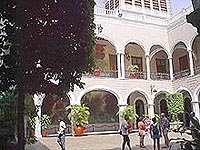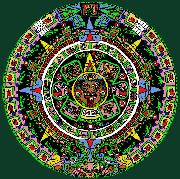MERIDA--THE
WHITE CITY OF THE YUCATAN
by
Marvin Perton
 The
early inhabitants of Merida "discovered" a plant that had been
a well-known staple to the indigenous Maya of the Yucatan Peninsula:
henequen (agave sisalana). A versatile, spiky, cactus-like bit of
green that yielded valuable hemp, it soon earned the name "green
gold" (verde de oro) because of the wealth it lavished upon
the millionaire hacienderos who farmed this cash-rich crop. The
early inhabitants of Merida "discovered" a plant that had been
a well-known staple to the indigenous Maya of the Yucatan Peninsula:
henequen (agave sisalana). A versatile, spiky, cactus-like bit of
green that yielded valuable hemp, it soon earned the name "green
gold" (verde de oro) because of the wealth it lavished upon
the millionaire hacienderos who farmed this cash-rich crop.
A look-alike for the blue
agave cactus used in making tequila, henequen (also called sisal),
still grown and processed in the Yucatan, has been relegated to the back
burner in favor of a 20th century, man-made fiber that is stronger, more
durable, and cheaper to produce: nylon. That, plus competition from many
of the world's developing nations, has put an end to sisal as a major
Mexican export.
By 1927, there were 658
haciendas growing and processing henequen; today, there are only a few.
Today, as you stroll along Merida's fashionable, Paseo de Montejo, with
its beautifully preserved French-style mansions (once the lavish
residences of henequen barons) that line both sides of this boulevard,
one can only imagine what life was like when sisal was king. Who lives
in these opulent homes now? Only a few are privately owned; the others
are now the offices of major insurance companies and banks. Even the
Casa de Montejo, built around 1550, home of several generations of the
Montejo family (and named for the founder of the city, Francisco de
Montejo el Mozo) is now a bank.
Merida's History
In 1542, the Conquistadores captured the Mayan stronghold of Ichcaanziho
and renamed this ancient city Merida, because it reminded them of the
city of Merida back home in Spain. A Maya stronghold long before the
arrival of the Spaniards, Merida still has its roots in the Maya
culture, but is now peppered with European touches as well.
Dazzling details like
tree-lined boulevards right out of a picture postcard sent from Paris;
filigreed wrought iron railings reminiscent of old Spain; beautifully
carved wooden doors; marble and mosaic floors; walled gardens; and
ornate fountains. They call it the "white city", La Ciudad
Blanca because it's so clean and white. It sparkles in Merida's
brilliant and perpetual sunshine. Merida is a genteel, laid-back
colonial city with a population of 700,000 and, paradoxically at times,
it's a bustling, sprawling traffic-clogged metropolis just like other
cities of its size.
Sights to See
The Spaniards built the Plaza Grande (the zócalo) on the rubble
of the ancient pyramids of T'hó. This is the colorful heart of the
city, with shops, restaurants, and hotels just blocks away. Visitors who
come here on fiesta days, when the locals display their wares, are in
for a treat.
On one side of the zócalo
is the Palacio de Gobierno and its arched courtyard, housing the
murals of a local Yucateco artist, Francisco Castro Pacheco. The murals
portray the history of the Yucatan. It is open daily and there's no
admission charge.
The man who was the
architect of the famous Morro Castle in Havana (Juan Miguel de Aguerro),
built the Cathedral, facing the zócalo which was completed in
1598. It is the oldest cathedral on the North American mainland and
contains many priceless relics.
One of the most beautiful
representations of Mayan life is housed in the Museo de Antropología e
Historia. It's a good place to start before touring the nearby Mayan
ruins. Merida is close enough to the Mayan ruins at Chichén Itza and
Uxmal and it's possible to do either on a one day trip.
The Convent Route (La
Ruta de los Conventos), easily done as a day trip, is dotted with a
string of 15th and 16th century convents/churches well worth visiting.
Mostly Franciscan in origin, some of the convents are quite ornate;
others are eloquent in their simplicity. A highlight of the route is the
village of Acanseh, and its convent which is directly opposite a small,
but ancient pyramid.
A good time to visit is
on December 12, when the locals celebrate the feast of Mexico's patron
saint, the Virgin of Guadalupe. Other villages like Tecoh, Tekit, Mama,
Chumayel, Teabo, Tipikal, Mani and Oxkutzcab are also interesting.
Mayaland (800-235-4079), with several locations in the city, operates
tours along the convent route and to the nearby archaeological sites.
The best way to tour Merida is on foot, but it could be more fun on a
horse-drawn calesa. There are also public buses, taxis and
rent-a-cars. But if you plan to walk the city, look for the two-seater confidenciale
benches which are perfect when your feet give out and you just want to
people-watch. Very romantic for two.
1
2
next
page-> |

